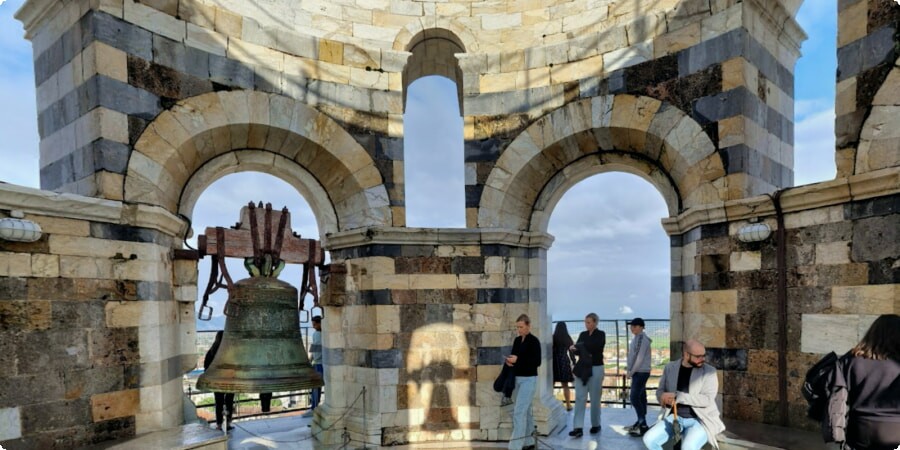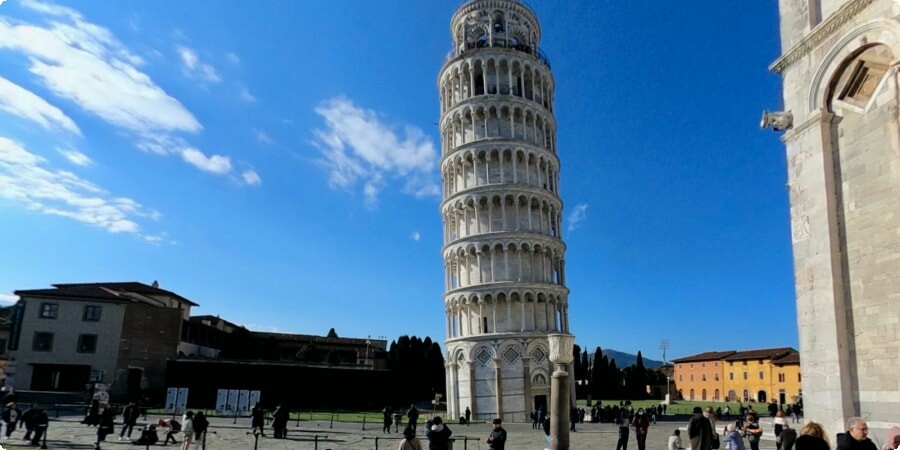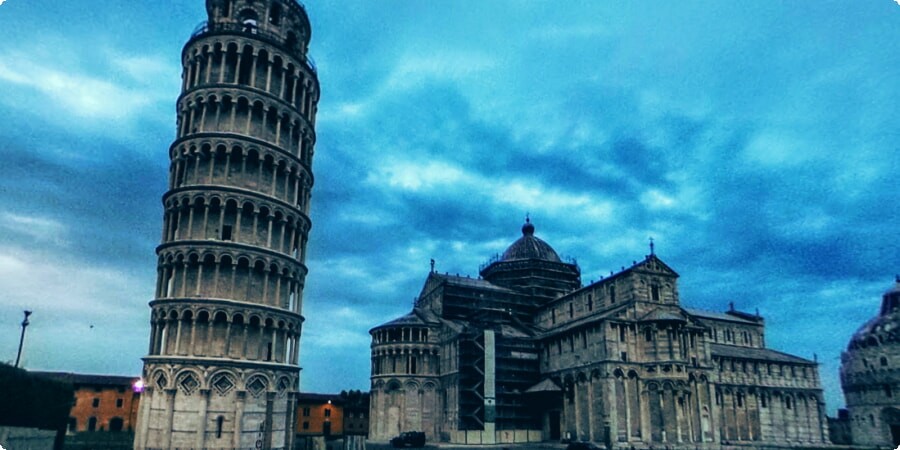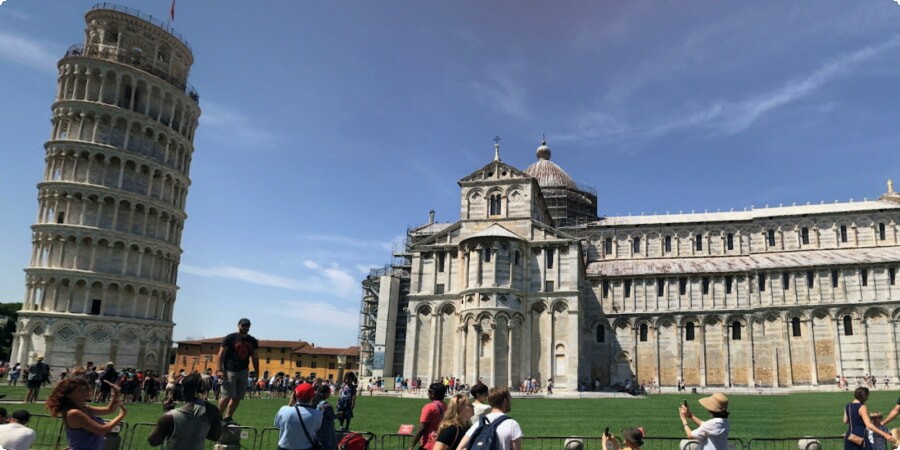In the heart of Italy, nestled amidst the picturesque city of Pisa, stands a marvel of architectural ingenuity and historical intrigue: the Leaning Tower of Pisa. This iconic landmark has captured the imagination of people worldwide, drawing visitors from far and wide to marvel at its unique lean and timeless beauty. Join us on a journey as we explore the fascinating history, engineering marvels, and cultural significance of Pisa's most famous icon, the Leaning Tower.
History of the Leaning Tower
The Leaning Tower of Pisa's story begins over eight centuries ago, in the 12th century, when construction first commenced. Designed to serve as the campanile, or bell tower, for the adjacent Pisa Cathedral, the tower's construction faced numerous challenges from its very inception. Built on unstable soil, primarily composed of soft clay, the tower began to lean to the southeast soon after the construction of its third floor.
Despite efforts to correct the tilt during construction, including adjustments to subsequent floors, the tower continued to lean, creating the iconic tilt that has made it famous worldwide. Completed in the 14th century, the Leaning Tower stands as a testament to both the ambitions of its builders and the unpredictability of nature.
Over the centuries, the Leaning Tower has witnessed a myriad of historical events, serving not only as a bell tower but also as a watchtower, defensive fortification, and symbol of civic pride for the city of Pisa. Despite wars, earthquakes, and the passage of time, the tower has remained steadfast, captivating generations of visitors with its lean and timeless allure.
To learn more about the history of the Leaning Tower of Pisa, visit its Wikipedia page here.

The Leaning Phenomenon
One of the most intriguing aspects of the Leaning Tower of Pisa is, undoubtedly, its famous lean. The tower's lean, which is estimated to be approximately 3.97 degrees off the vertical axis, has puzzled engineers, architects, and visitors alike for centuries.
The cause of the tower's lean can be attributed to a combination of factors, including its weak foundation, soil subsidence, and construction techniques employed during its construction. Built on a dense clay soil that lacks sufficient support, the tower began to tilt during the early stages of construction, as the weight of its marble exterior exerted pressure on the underlying soil.
Efforts to correct the lean, such as adding extra masonry to the shorter side of the tower or altering the angle of subsequent floors, only served to exacerbate the problem, causing the tower to lean further. Despite attempts to stabilize the tower in modern times, including the installation of counterweights and soil extraction, the lean persists, adding to the tower's mystique and allure.
To catch a glimpse of the Leaning Tower's lean for yourself, explore its Google Maps location here.
Architectural Features and Design
As you stand in awe of the Leaning Tower of Pisa, it's hard not to be captivated by its architectural beauty and unique design. The tower stands at approximately 55 meters tall and consists of eight stories, each adorned with columns, arches, and intricate carvings that showcase the craftsmanship of its builders.
Constructed primarily of white marble, the tower's exterior is adorned with blind arcades and decorative motifs typical of Romanesque architecture. The tower's lean, caused by its unstable foundation, adds an element of drama and intrigue to its appearance, drawing visitors from around the world to marvel at its tilt.

Despite its lean, the Leaning Tower of Pisa remains a marvel of engineering, with its builders employing various techniques to ensure its stability, including irregular spacing of the tower's columns and a slight curvature in its construction. Today, the tower's lean is carefully monitored, with ongoing efforts to preserve its structural integrity for future generations to enjoy.
For travelers seeking to explore Pisa and its surrounding attractions at their own pace, consider renting a car through this link to enhance your journey through Italy's historic landscapes.
Cultural and Symbolic Significance
Beyond its architectural beauty and engineering marvels, the Leaning Tower of Pisa holds deep cultural and symbolic significance for the city of Pisa, Italy, and the world at large. As a symbol of Italian Renaissance architecture and engineering prowess, the tower represents the ingenuity and innovation of its builders, who overcame countless obstacles to create a lasting monument to human achievement.
The Leaning Tower also serves as a potent symbol of civic pride for the city of Pisa, attracting millions of visitors each year and generating economic opportunities for the local community. Its lean has become synonymous with the city itself, symbolizing resilience, perseverance, and the triumph of human creativity over adversity.
Moreover, the Leaning Tower of Pisa has left an indelible mark on popular culture, appearing in countless works of art, literature, and film. Its iconic lean has inspired awe and wonder in generations of visitors, earning it a place in the hearts and minds of people around the world.
Visitor Experience
Visiting the Leaning Tower of Pisa is an unforgettable experience that offers something for everyone. Whether you're a history buff, an architecture enthusiast, or simply looking to snap the perfect vacation photo, the tower's lean is sure to leave a lasting impression.
Upon arriving at the site, visitors can purchase tickets to enter the tower and climb its spiraling staircase to the top, where panoramic views of Pisa and the surrounding countryside await. Along the way, be sure to admire the intricate details of the tower's interior, including its ornate frescoes and ancient bells.

In addition to exploring the tower itself, visitors can also enjoy leisurely strolls around the Piazza dei Miracoli, or Field of Miracles, where the tower is located. Here, you'll find other architectural marvels, including the Pisa Cathedral and Baptistery, as well as lush green lawns perfect for picnicking and soaking in the sun.
Whether you're marveling at its lean from afar or climbing to the top for a bird's-eye view of Pisa, visiting the Leaning Tower is an experience you won't soon forget.
Preservation Efforts and Future Prospects
Preserving the Leaning Tower of Pisa for future generations is a top priority for the city of Pisa and heritage conservationists worldwide. Over the years, numerous preservation efforts have been undertaken to stabilize the tower and prevent further leaning, ensuring that it remains a safe and iconic landmark for years to come.
One of the most significant preservation projects took place in the late 20th century when engineers embarked on a daring endeavor to reduce the tower's lean. By carefully extracting soil from underneath the tower's foundation and installing counterweights, they were able to stabilize its tilt and prevent further movement. Today, the tower's lean is monitored using sophisticated instruments to detect any signs of instability and ensure its ongoing preservation.
Looking ahead, the future prospects of the Leaning Tower of Pisa are bright, with ongoing efforts to promote sustainable tourism and protect its cultural heritage. By implementing measures to reduce visitor impact, such as limiting the number of daily visitors and enforcing strict conservation guidelines, authorities aim to strike a balance between preserving the tower's integrity and providing a positive visitor experience.
Beyond the Tower: Exploring Pisa
While the Leaning Tower of Pisa may be the city's most famous attraction, there is much more to discover in Pisa beyond the iconic landmark. From its historic churches and bustling piazzas to its charming streets and vibrant markets, Pisa offers a wealth of experiences for visitors to enjoy.
Begin your exploration of Pisa by visiting the Pisa Cathedral, a masterpiece of Romanesque architecture renowned for its striking facade and magnificent interior. Next, wander through the winding streets of the city center, where you'll find quaint cafes, artisan shops, and hidden gems waiting to be discovered.

For art lovers, a visit to the Camposanto Monumentale is a must, housing an impressive collection of frescoes and sculptures dating back to the Middle Ages. And don't forget to stroll along the banks of the Arno River, where you can admire the picturesque views of the city's historic bridges and medieval towers.
After a day of sightseeing, be sure to indulge in some of Pisa's culinary delights, from traditional Tuscan dishes to mouthwatering gelato. Whether you're savoring a slice of pizza al fresco or enjoying a leisurely dinner at a local trattoria, Pisa's culinary scene is sure to satisfy even the most discerning palates.
Traveling to Pisa
For travelers looking to embark on their own Italian adventure, Pisa is easily accessible from major cities across Italy and Europe. The city is served by the Galileo Galilei International Airport, which offers direct flights to destinations around the world.
Additionally, Pisa is well-connected by train, with regular service to Florence, Rome, and other major cities in Italy. From the train station, it's just a short walk or bus ride to the city center, where the Leaning Tower and other attractions await.
For those looking to explore Pisa and its surrounding areas at their own pace, consider renting a car through this link to enhance your journey through Italy's historic landscapes. With your own vehicle, you can easily explore the picturesque countryside, charming hilltop towns, and hidden gems waiting to be discovered.
